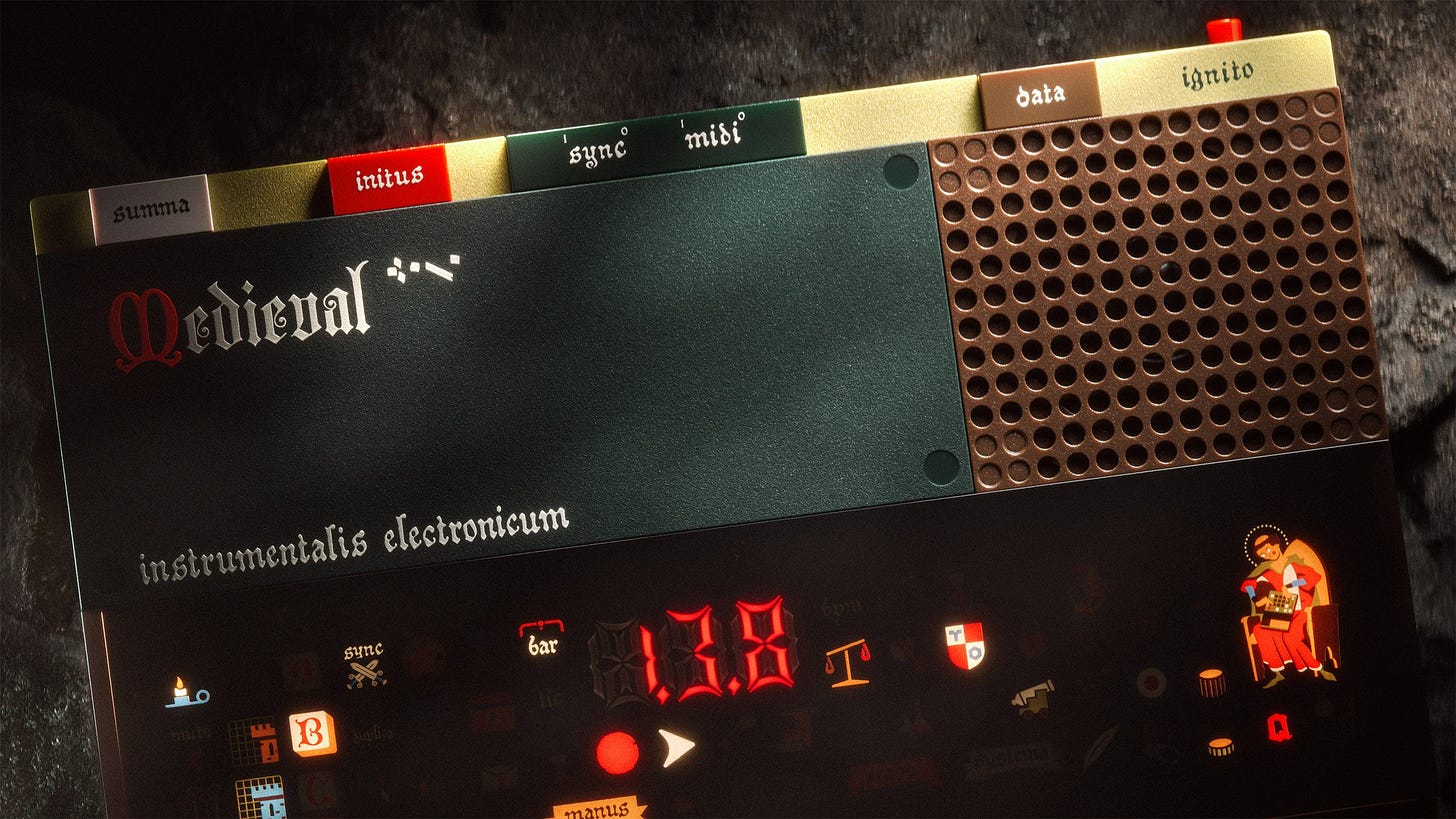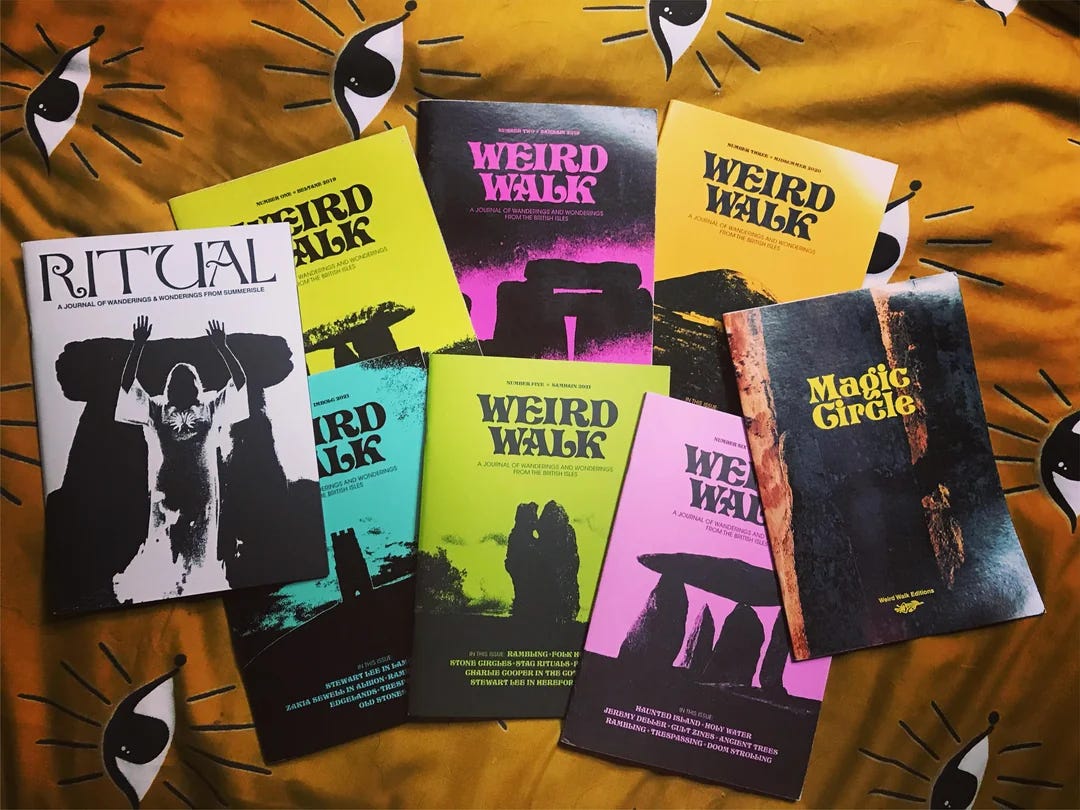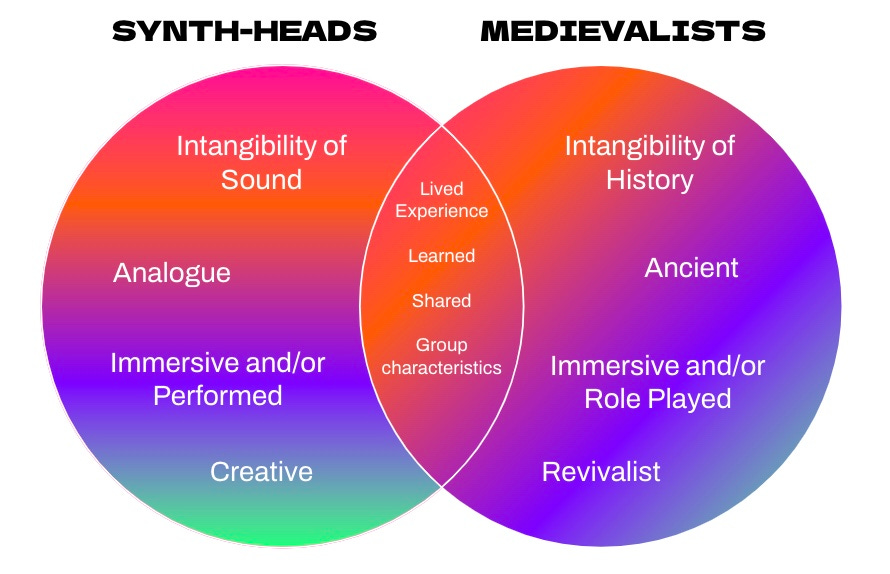In early August, tech design company Teenage Engineering (TE) dropped one of the most obscure products conceivable; a “Medieval Synthesizer.”
Maybe you’re wondering what in the name of Lancelot a medieval synthesizer is.
Perhaps you’re into jousting.
Perhaps you’re a fan of Italo Disco circa 1984.
Even if you’re not into these, you might be intrigued as to how a Swedish company - started by the founder of Acne clothing - came to create a medieval electronic instrument. What could the strategic rationale behind this possibly be?
Well, Hear Ye!
If you were to take TE co-founder, Jesper Kouthoofd, at his word, he was ‘simply walking through the charming old streets of Gamla Stan in Stockholm and came up with the idea’. This may well be the case, however, I suspect some ‘joustification’ was required to actually make this device financially viable so it could be put into production.
You would be forgiven for thinking that synths and medievalism cater to two completely different interest groups. However, this article explores the common ground found within these sub-cultures.
Let’s start with the medieval. In recent years, the huge popularity of the Lord of the Rings ($6 billion box office sales) and Game of Thrones franchises have fuelled an appetite for medieval-based storytelling.
In gaming, Elden Ring has been hugely successful (25 million units sold), drawing fans into an immersive medieval experience. In an earlier example, the game Moonstone a 1991 Amiga 8-bit ‘beat-em-up’ - centered on a Knight and featured gory sound effects and chanting monks. Gaming has continued the tradition that graphic novels and comics started, enabling fandoms to express themselves by dressing up at events such as ComicCon and immersing themselves in LARP (Live Action Role Play) life. Other gaming franchises, such as those from Wizards of the Coast; Dungeons and Dragons, and Magic the Gathering, also enable deep fandom to thrive.
Whilst these are not strictly medieval-themed, they are adjacent. And this is key.
In recent years, another medieval adjacent movement came to prominence, crossing over into hipsterdom. Mythology and spirituality. This has presented in various ways, including the huge popularity of tarot cards…. but of particular note is a culture that takes its cues from the ancient countryside.
Within this context, mushrooms are a phenomenon, both as a design motif and as a drug. A 2023 ONS report suggested that 260,000 people in England took ‘magic mushrooms’ in the previous year. 100,000 more than in 2020. Through TV shows, such as Nine Perfect Strangers, social media, and other outlets, micro-dosing has been packaged up as a neat way to enhance one’s mood and creativity (Harvard Health). Admirably, this is part of a renewed appreciation of nature, however, underlying this is the continued focus on and commercialisation of wellness.
Another example is Ffern fragrances, which, in the pursuit of environmentally friendly, small-batch production, only releases new products quarterly, aligning with the seasonal equinox and solstice. Their ledger business model is currently closed to new sign-ups due to demand.
The magazine and cultural hub, Weird Walk, continues the path. This platform, with its merch, zines, and podcast, promotes a lifestyle that celebrates centuries-old history and embraces a slower, more ancient way of being—one that revels in eerie adventures like misreading maps, sleeping in haunted pubs, and exploring Neolithic burial chambers. It is, however, a brand with products. I saw somebody wearing one of its T-shirts on a London street last week. Similarly, NTS Radio, has just launched a ‘Medieval Players’ beach towel and mug. There seems, then, to be a trend in productising medievalism and paganism.
A selection of Weird Walk zines
A recent article by George Francis Lee in The Fence, explores the rise of paganism on digital platforms:
“…not how you’d expect to find pagans in the woods, but this is how paganism works now. It’s very online and very keen for new converts, curious folk like me.”
In addition to the environmental crisis as a backdrop, the uptick of interest in these things can unsurprisingly be tracked back to the overstimulation we all face in modern life. We spend so many waking hours looking at screens but it doesn’t seem to be making the world any better, therefore, it stands to reason that more people will try to find alternatives, including disconnection from technology.
Although these products and lifestyles promise a route to mystical discovery, they are paradoxically, initially or primarily accessed through industrialised technology, including social media.
So, what does this have to do with synthesizers?
The band Heilung, who performed at Glastonbury this year, Swedish artists Fever Ray and Goat, and Snapped Ankles who are known for performing dressed as trees, all portray the mystical visually and musically and have helped beat the drum of alternative folklore in recent years. Rewinding to the days of indiesleaze circa 2007/8, Klaxons and Late of the Pier also ventured into mythical territory.
Snapped Ankles
Used widely across many musical genres, synthesizers have in recent years taken a rather unexpected path. Among the growth in popularity of vinyl (sales increased 12% last year), the curveball allure of wired headphones, dumb phones, and widespread nostalgia, interest in analogue and modular synthesis has surged. The YouTuber Cuckoo, and Sarah Belle Reid are two such creators helping to popularise the discipline. While store channels such as Anderton’s are helping fuel sales.
While using a computer programme such as Ableton with plugins and VSTs gives unrestricted access to a world of sound, this relationship with music is restricted in that it is two-dimensional. Tired of staring at screens, hobbyists, producers and musicians are increasingly drawn to analogue synthesizers. Users flick switches, turn knobs, press keys, and patch cables between devices. Whilst TE’s EP synths are technically digital, they are complementary to an analogue studio setup, lo-fi, deeply nostalgic and tactile.
Seemingly disparate, the two sub-cultures actually have parallel values; honouring a previous way through creativity, and immersion as means to explore something intangible.
It therefore makes sense to bring these two audience niches together, whilst also playfully acknowledging the nonsense of it. TE successfully does this through brand films, merchandise, graphic design choices, and synth sound effects, including sword swings, severed heads, dragons, farm animals, lutes, and Gregorian chants—oh, and not forgetting the device has cocoa-scented buttons.
To launch its new product, TE embraced medieval life, travelling to the island of Gotland to take part in its annual eight-day long and historically accurate celebration: ‘Medieval Week’. TE unveiled the EP-1320 during the festival, parading the island whilst performing an improvised set using the synth.
Teenage Engineering’s EP-1320 BTS launch video
This device is not intended to appeal to as many people as possible. The aesthetic, which includes medieval fonts and flourishes, is somewhat chaotic. It will, however, appeal to an overlap of consumers. In part because the product is bizarre and also because some people will feel catered for. Brands and products that make people feel seen and special will always find buyers.
TE has identified a hyper-niche audience or, even engineered an overlap, to market its product to. One that communicates its brand mentality and ethos, drawing attention to itself. Not all positive, it must be added!
As the second device in the EP series, future iterations will likely continue to explore and fulfil audience overlaps, which other brands would be wise to explore…. whether any will be quite as obscure as Medieval Techno remains to be heard.










